Feeders and Feeding Hummingbirds (The Entire Article)
TOPICS COVERED:
Selecting a Feeder
Red Food Coloring and Commercial Nectar Mixes
Why you should never use honey.
Proper Sugar Solution Recipe
Cleaning Your Hummingbird Feeder
How Many and Feeder Placement
What else can I do to attract hummingbirds?
There are literally dozens of styles of hummingbird feeders on the market today. (Hummingbirds are BIG!) None of the feeders are truly "wrong" as long as a hummingbird will use them, but some are "better" than others. Hummingbird experts prefer the newest "flying saucer" style hummingbird feeders, although almost any style of hummingbird feeder has the potential to attract hummingbirds. The cost runs a little on the high side for the "really good", engineered-for-hummingbird feeders but in the long run these feeders pay for themselves; they tend to be more reliable, are easier to use and maintain than other hummingbird feeders, and some even come with lifetime warranties.
A couple of comments on selecting a hummingbird feeder: The easier it is to use and clean, the more likely you are to keep it cleaned and filled. Clean and filled feeders will attract more hummingbirds. That said, there are some quite lovely "hummingbird feeders" around today that seem more works of art than bird feeders. As long as they can beand arekept thoroughly clean, and have most of the other features listed below, they should work.
In addition to tips on selecting a hummingbird feeder, this FAQ's page also has the hummingbird experts' recommended recipe for the nectar (sugar) solution, suggestions on feeder maintenance and placement, and additional suggestions for attracting and enjoying hummingbirds, as well as a couple of "Dont Do's" with explanations.
Please check the other Garden Web: Hummingbird Garden Forum FAQ's pages (available as we are able to post them), and always feel free to post a message or a question on the forum itself.
Features to Look for When Choosing a Hummingbird Feeder: (in no particular order)
* red color The most attractive color to hummingbirds is red. Look for red in the feeder itself rather than relying on dye to color the sugar solution. Hummingbirds are very inquisitive and even just a little bit of red on the feeder itself is quite sufficient. (See below for more on red dye.)
* ant protection Built in ant moats (check the feeder's packaging) or add-on ant moats solve most of the ants-at/in-the-feeder problem.
* bee guards The most attractive color to bees and wasps is yellow. Newer model feeders from most manufacturers no longer have yellow parts. Look for hummingbird feeders that claim on their packaging that their shape discourages bees from reaching the nectar (usually found with saucer-shaped styles).
* built in perches Hummingbirds prefer to sit when they feed if they are able to do so.
* size of feeder The smaller the better, until you determine how heavy the hummingbird usage is.
* ease of cleaning There should be no little nooks and crannies in the feeder for mold to lurk in. A dishrag, a small bottle brush (an old, clean toothbrush is wonderful!), and a clean pipe cleaner should be sufficient tools for cleaning. Also very helpful are the tiny brushes specifically marketed for cleaning hummingbird feeder ports.
* ease and cleanliness of use Look for feeders that do not require excessive twisting or snapping to be put together; this reduces the chance of sloshing sticky sugar water all over the feeder. (And your countertop, your shoes, your kitchen floor, your patio)
* rain guard Some hummingbird feeders with their feeding ports located on top of the solution reservoir may allow rain water to get into the feeder and dilute (and possibly contaminate) the sugar solution. Check the feeder packaging to see if a particular model is designed to limit this problem. There are also "rain guards" available, metal or plastic disks meant to hang above a feeder, marketed specifically for hummingbird feeders.
* wind resistance Feeders hung in very windy locations may spill and make quite a mess doing so; at least one manufacturer is making a saucer style feeder that can be pole-mounted.
* instructions Some feeders have the nectar recipe permanently imprinted onto the feeder itself.
Why You Really Shouldn't Use Red Coloring or Commercial "Nectar Mixes":
It has not been proven-beyond-any-doubt that the red dye is harmful to hummingbirds but since it is unnecessary to use dye if your hummingbird feeder already has some red on it, why take the chance that red dye might be bad for the birds in the long run? Natural flower nectar isn't colored, so why put something in your sugar solution that the real thing doesn't have?
As for those nectar mixes, not only are they quite a bit more expensive than ordinary white table sugar, wild hummingbirds do not need the "added vitamins and minerals". Flower nectar is, for the most part, pretty much just sugar (sucrose) water. Hummingbirds in the wild get the vital nutrients they need mainly through the insects they eat--which some scientists say could be as much as half their diet. (A hummingbird that appears to be nectaring at any particular flower may instead really be hunting the insects that are attracted to the flower.) Many hummingbird researches feel that nectar is in actuality just the fuel these birds use to power their search for bugs.
Why You Should NEVER Use Honey:
A honey water solution served up in hummingbird feeders can quickly become toxic and deadly. Honey rapidly ferments and also cultures a deadly bacterium. Contrary to popular belief, honey is not "more natural" than the cane sugar that is sold as white sugar. Honey has been chemically altered by honey bees: it is flower nectar and whatever ever else the honey bee ingested, digested, and spit back out again. Honey is nothing like the sucrose found in flower nectar and white sugar.
Again, plain white table sugar dissolved in water in a four-to-one solution (see below) is about as close to real flower nectar as you can get.
The Proper Sugar Solution Recipe for Feeding Hummingbirds:
Four parts water to one part white sugar. (For instance, one quarter cup of sugar stirred into one cup of water.)
Tap or well water is preferred; do not use distilled as it takes out too many naturally occurring minerals. If you use a water softener, you may want to use partial or totally filtered water; softeners may add too many minerals and salts to the water.
Room Temperature Method: Use very warm water (not hot) right out of the tap. Some brisk stirring is all that is required to dissolve the sugar. Let it cool a bit before setting out a feeder if the sugar water is hot to the touch.
Boiling Method I: Some people prefer to boil their sugar solution to retard the growth of bacteria and mold. Use boiling water to mix up the above-mentioned sugar solution; allow it to cool before placing outside.
Boiling Method II: Sometimes you may still have problems even if you have been boiling your water; the trouble could be contamination in your sugar. This method should take car of the problem. Mix up the 4:1 water-to-sugar solution in your normal preparation amount. Bring this to a boil on the stove and allow it to boil for a minute or two. Bring more (plain) water to the boil in another container at the same time. Pour the boiled sugar solution into a clean and sanitized measuring container (you don't want to undo your efforts!). If some water boiled off, add plain boiled water to the boiled sugar solution to bring it back up to the original amount it was before boiling. It's a bit more work, but the boiling method tends to extend the "shelf life" of the sugar solution.
Sugar solution can be made ahead and kept up to a week in the refrigerator.
Discard any sugar solution that has turned cloudy or contains black mold, no matter how "fresh" the solution is.
A tip: Only fill your feeders with enough sugar solution to last, at the most, two or three days. There is no sense in throwing most of the sugar water away when it goes bad before the hummingbirds drink all or most of it.
Winter Sugar Solutions: If you feed hummingbirds during below-freezing temperatures (yes, you can do this without preventing their migration: see the Winter Feeding FAQ page), raising the concentration of the sugar solution to 3 parts water: one part sugar can usually prevent the feeder from freezing up at temperatures around and below 25°F.
Cleaning Your Hummingbird Feeder:
Sugar solutions last about three to five days under normal outdoor conditions, longer in the cold and less in extreme heat. Feeders should be emptied and cleaned as soon as the sugar solution starts to appear cloudy (which can be in only a day or two if it is very hot or the feeder is in a sunny location, or if your feeder or solution is contaminated). There are a few different ways to clean and sanitize your feeder; no matter your choice, always rinse your feeders thoroughly after washing. Rinse, rinse, rinse; and when you think you've rinsed enough, rinse one last time.
Various cleaning methods include washing in warm water and mild dish soap; in boiling water only or with boiling water and a mild dish detergent; or washing with vinegar and water. Rinse well if you use anything in addition to plain water.
Feeders washed with warm water or warm water and soap can then be sanitized by soaking them in a mild bleach solution (in a 1:10 ratio = one part bleach, ten parts water; I usually go for one small "glug" of bleach per sink-full of water) for an hour, followed by lots and lots of rinsing.
Remember: rinse well!
There is no need to dry your feeders before refilling them.
How Many Feeders and Where Should I Put Them?
Put out as many feeders as you are willing and, most importantly, are able to maintain. (It is even better if you also garden for hummingbirds.) Having more feeders/plants may help lessen the competition amongst hummingbirds, especially if the feeders are hung out of sight from one another (and the gardens are well-spaced). You may want to check this by thinking like a hummingbird... You may not be able to see both feeders from inside your house, but a highly territorial hummingbird will find the perch outside that overlooks both!
Experiment with feeder locations; once a hummingbird has discovered that a feeder is a reliable source of food, it will remember exactly where that feeder is. Go ahead and hang a feeder right up close to your house or even on a window. (Just be aware of the potential for window collisions on unprotected, reflective glass and with screened porches and other large screened-in structures.) Hummingbirds are rather fearless, and don't mind being observed close at hand if you don't make any sudden moves.
Note: The sugar solution in feeders in full sun may spoil more rapidly than that which is in shaded feeders.
What Else Can I Do to Attract Hummingbirds?
Planting native flowering plants known to attract hummingbirds is always the best option for feeding hummingbirds. The list of favorite hummingbird plants, both native and non-native, is too long to go into here. There are many resources available today in which to find nectar plant information specific to your region.
Maintain native habitat to encourage hummingbirds to visit your yard.
For a special hummingbird treat, try putting out an opened banana on a plate. The fruit should attract fruit flies, and hummingbirds love to eat fruit flies. (A side benefit to this is that you may also attract a wide variety of butterflies, as well.)
A final note: Hummingbirds like to bathe just as much as any other bird, but prefer water dripping off of leaves or spray coming from sprinklers and pond fountains. Try locating one of the many commercial "misters" amongst a leafy bush or tree. Any number of small birds will enjoy it as much as the hummers.
Feeder and Feeding Facts ©ALG and GARDEN WEB. Please reference these sources if you use the above information as presented here in any form or media other than for personal, individual use.
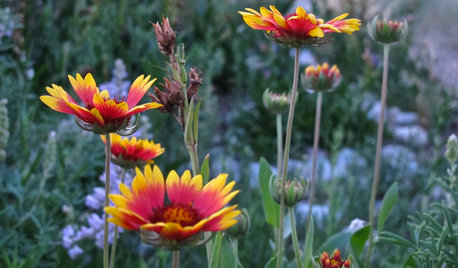


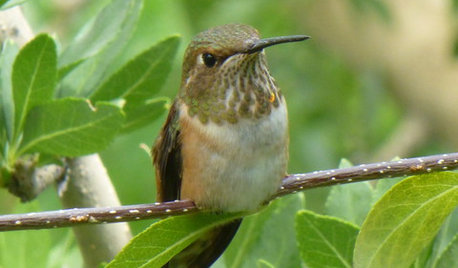

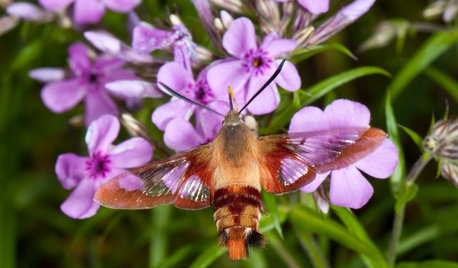
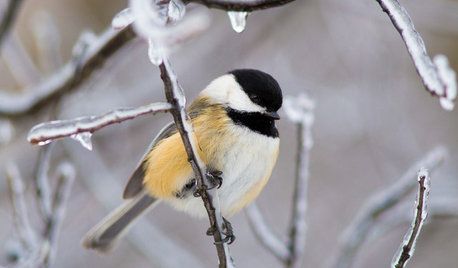


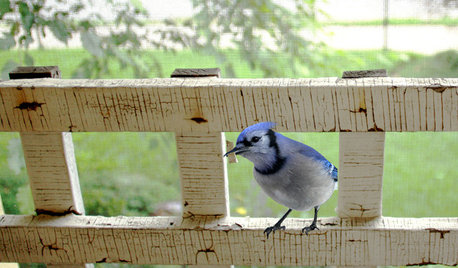



Related Discussions
Rufus hummingbird at the feeder 12/6/09
Q
feeding bees in winter/spring
Q
Hummingbird Feeder Preference
Q
Feed the hummingbirds!!
Q